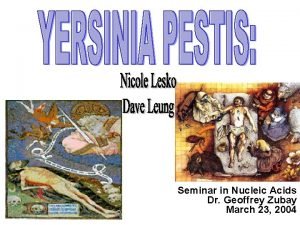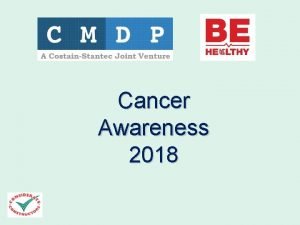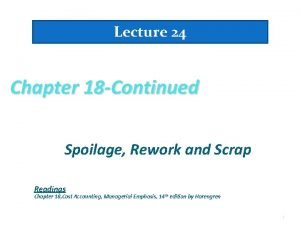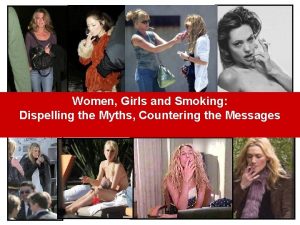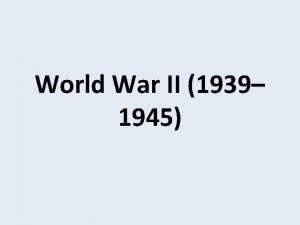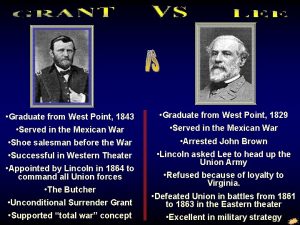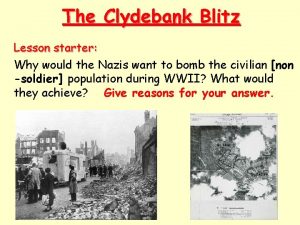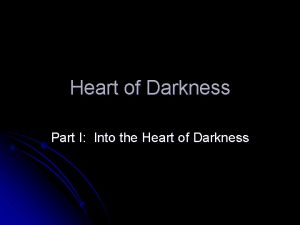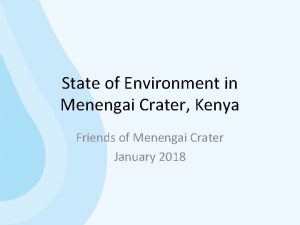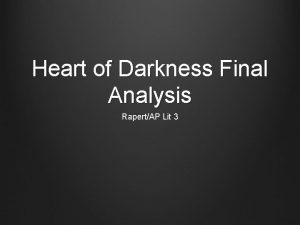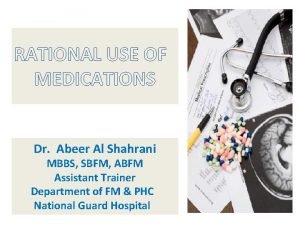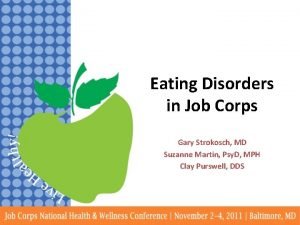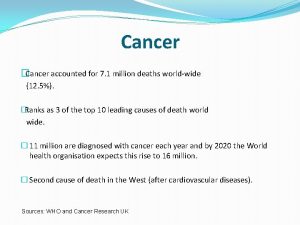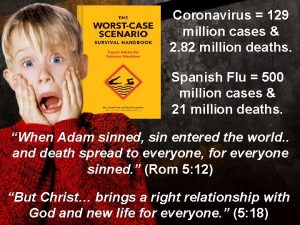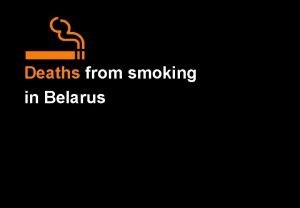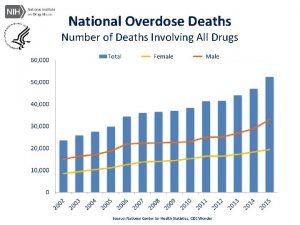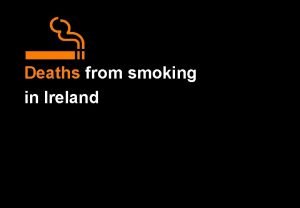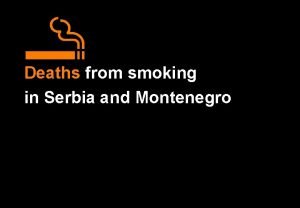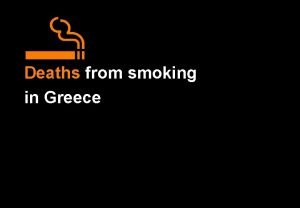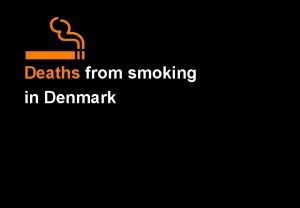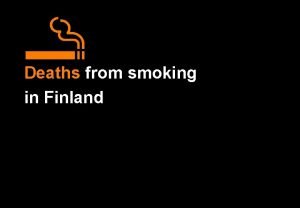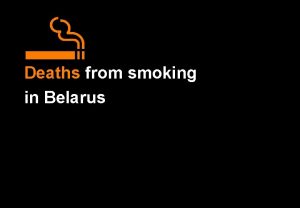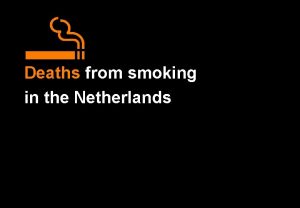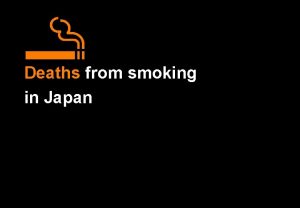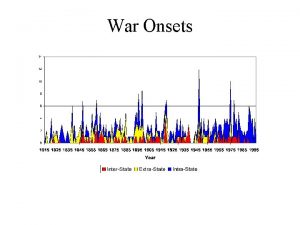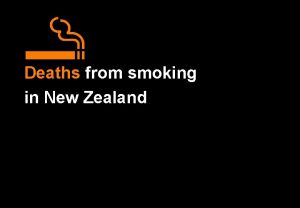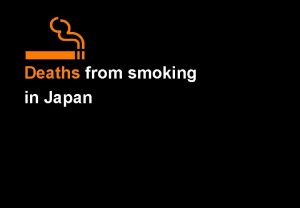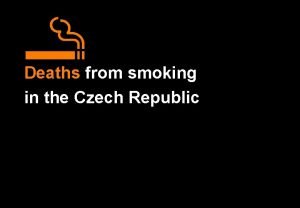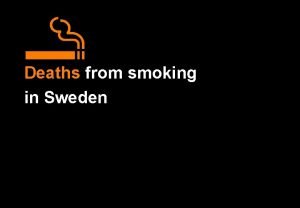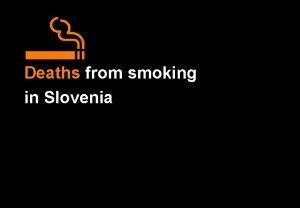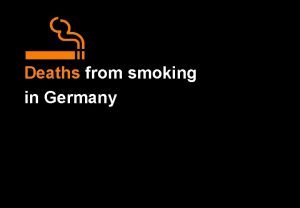Cancer Cancer accounted for 7 1 million deaths























- Slides: 23

Cancer • Cancer accounted for 7. 1 million deaths world-wide (12. 5%). • Ranks as 3 of the top 10 leading causes of death world wide. • 11 million are diagnosed with cancer each year and by 2020 the World health organisation expects this rise to 16 million. • Second cause of death in the West (after cardiovascular diseases). Sources: WHO and Cancer Research UK

Pathogenesis of cancer • DNA mutations – Inborn mutations of cancer susceptibility genes – Acquired mutations • Other epigenetic factors – Chemical carcinogens – Virus-induced cancer – X-rays – Other risk factors (tobacco, alcohol, Asbestos, diet)

Cancer • Genetic mutations within a single affected cell leads to monoclonal development. Genes affected can be those controlling cell cycle, DNA repair and/or differentiation, This leads to uncontrolled proliferation and tumour formation.

Cancer Types categorized based on the functions/locations of the cells from which they originate: – Carcinoma: a tumor derived from epithelial cells, those cells that line the surface of our skin and organs (80 -90% of all cancer cases reported) – Sarcoma: a tumor derived from muscle, bone, cartilage, fat or connective tissues. – Leukemia: a cancer derived from white blood cells or their precursors. – Lymphoma: a cancer of bone marrow derived cells that affects the lymphatic system. – Myelomas: a cancer involving the white blood cells responsible for the production of antibodies (B lymphocytes).

Causes of cancer • 30% of cancer is due to smoking. • 30% of cancer cases is diet related. • 15% of cases are viral related infections: – Papilloma virus… sexually transmitted… cause cervical cancer. – Hepatitis-B is the cause of 80% of liver cancer. • Some are bacteria related: – H. pylori…. Leads to stomach cancer.

The Classification of Anticancer Drugs n According to chemical structure and resource of the drug: – Alkylating Agents – Anti-metabolite – Antibiotics – Plant Extracts – Hormones

Problems with chemotherapy • Treatments are non-specific, attack healthy cells as well as normal cells since cancer cells are derived from normal cells. • Cancers can develop resistance: for example with platinum-drugs, cancer cells became resistant by many ways: – – Decreased drug uptake/increased efflux Enhanced tolerance of DNA adducts Enhanced repair of DNA adducts Increased drug deactivation by intracellular glutathione

Ideal cytotoxic drugs should: • Selectively target cancer cells without causing damage to normal cells. • Reduce size of tumors + minimize risks of metastases. v unfortunately, most of the available agents are not selective, they also affect rapidly-proliferating normal tissues (bone marrow, gastro intestinal epithelium, hair cells, …), causing serious side-effects (bone marrow suppression, nausea, vomiting, …).

alkylating agents • • • Nitrogen mustard Nitrosourea Busulfan Cisplatin and Cisplatin Analogues Dacarbazine and Procarbazine Mitomycin C

Chemical Warfare – circa 1914 • Two most common agents: • Chlorine gas • Mustard gas

Alkylating Agents Mechanism of Action • Nitrogen mustards inhibit cell reproduction by binding irreversibly with the nucleic acids (DNA). The specific type of chemical bonding involved is alkylation. After alkylation, DNA is unable to replicate and therefore can no longer synthesize proteins and other essential cell metabolites. Consequently, cell reproduction is inhibited and the cell eventually dies from the inability to maintain its metabolic functions.

Alkylating Agents • Alkylating agents are reactive compounds that act on DNA, RNA or enzymes. • Cells are killed by the alkylation of DNA – Formation of a covalent bond between drug and DNA (usually N 7 on G) to form crosslinks – Methylation at N 7 • Procarbazine, streptozocin, dacarbazine, temozolomide • Drug resistance is common

nitrogen mustard • amino acid, nucleic base or hormone uptake by carrier protien Melphalan Uracil Mustard Estramustine L-phenylalanine (amino acid) Uracil nucleic base)) Estradiol (sex hormone)

Nitrogen Mustard chloroethylamino structure (NCH 2 -Cl) nucleophile electrophile Mechlorethamine (or Chlormethine) Electrophilic carbon

MOA: Nitrogen Mustards Generation of highly reactive “aziridinium ions” that act as alkylating agents to cross-link DNA producing defective DNA and abnormal cellular function and eventually cell death

Nitrogen Mustards Extravasation a problem – 0. 16 M sodium thiosulfate and ice packs, {antidote for extravasation} highly reactive aziridinium ion N, N-bis(2 -chloroethyl)methylamine Injection only, monitor renal, hepatic and bone marrow MOST reactive of the mustards

Nitrogen Mustards Theoretical rationales used to improve nitrogen mustards -Substituting an aromatic ring for methyl group can be predicted to increase chemical stability and thereby decrease the rate of alkylation because of electron-withdrawing effect. This also, will lead to good oral bioavailability, tissue distribution, before alkylation is widespread. E. g. Chlorambucil, and melphalan. Chlorambucil 4 -(p-bis(2 -Chloroethylamino)phenyl)butyric acid.

Synthesis Ethylene oxide (oxirane) Phosphoryl chloride

Nitrogen Mustards Oral or IV, severe bone marrow suppression resulting in infection and bleeding Dosage reduction may be necessary in renal failure as measured by BUN Known to cause chromosome abnormalities


Nitrogen Mustards To increase selectivity, nitrogen mustards was bonded with natural carrier e. g. estramustine which is active against prostate cancer, another examples is the bonding with antimetabolites e. g. uracil mustard.

Estramustine phosphate Estracyt® Pro-drug

Ideal cytotoxic drugs should: • Selectively target cancer cells without causing damage to normal cells. • Reduce size of tumors + minimize risks of metastases. v unfortunately, most of the available agents are not selective, they also affect rapidly-proliferating normal tissues (bone marrow, gastro intestinal epithelium, hair cells, …), causing serious side-effects (bone marrow suppression, nausea, vomiting, …).
 World million deaths
World million deaths Tobacco causes _______ of cancer deaths around the world. *
Tobacco causes _______ of cancer deaths around the world. * Exspektans eller expektans
Exspektans eller expektans Accounting chapter 6
Accounting chapter 6 Costs of normal spoilage are usually accounted for as
Costs of normal spoilage are usually accounted for as Fixed assets are ordinarily presented on the balance sheet
Fixed assets are ordinarily presented on the balance sheet Consolidated retained earnings
Consolidated retained earnings Deaths from smoking
Deaths from smoking Ava fontaine
Ava fontaine World war 2 countries
World war 2 countries West point graduate deaths
West point graduate deaths Birth deaths marriages tasmania
Birth deaths marriages tasmania Clydebank blitz map
Clydebank blitz map Heart of darkness part 2 summary
Heart of darkness part 2 summary Menengai crater fire
Menengai crater fire Lincoln interpreted his reelection as a mandate to
Lincoln interpreted his reelection as a mandate to Heart of darkness deaths
Heart of darkness deaths Dr abeer deaths
Dr abeer deaths 2020 motor vehicle deaths
2020 motor vehicle deaths Chipmunk face bulimia
Chipmunk face bulimia Referat mall
Referat mall Myndigheten för delaktighet
Myndigheten för delaktighet Byggprocessen steg för steg
Byggprocessen steg för steg Mjälthilus
Mjälthilus
